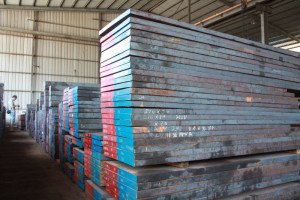4150 Alloy Steel/G14500
ASTM 4150 Alloy steel/G14500 is a higher carbon variation of chromium, manganese, molybdenum 4100 low alloy steel. It is also low-alloy steel containing chromium and molybdenum as strengthening agents.
Supply Form of 4150 Alloy Steel
- Round
- sheet
- Plate
- Square
Supply Range of 4150 Alloy Steel
ASTM4150 Steel Round Bar : diameter 1-400mm Length: 3000-5800mm
ASTM4150 Steel Plate: thickness 1-500mm Width :1-1500mm Length:2000-4000mm
ASTM4150 Steel Block : thickness 1-1000mm Width 1-1500mm Length:2000-4000mm
Chemical of Composition of 4150 Alloy Steel
| ASTM 4150 | C | Mn | P | S | Si | Cr | Mo |
| 0.48-0.53 | 0.75-1.00 | 0.035 | 0.04 | 0.15-0.35 | 0.80-0.1 | 0.15-0.25 |
Machinability
Machinability of 4150 is good in the annealed condition, or in the normalized condition. After heat treatment the alloy can be very hard and it is best to limit machining at that point to grinding.
APPLICATIONS
This alloy steel is used as forgings in the aerospace and oil and gas industries and has myriad uses in the automotive, agricultural and defense industries. It could applicate to many ranges of ways with modern life growth.
Condition of ASTM 4150 Alloy Steel
Forging
This steel should be forged between 2200 and 1600 º F (1200 and 870 º C.) The lower the finishing temperature from forging, the finer will be the grain size. This alloy should ideally not be forged below 1600 º F (870 º C) and should be slow cooled after forging.
Heat Treatment
The alloy is heat treated to render it suitable for machining, and to meet the mechanical property ranges specified for its particular applications.
Annealing
Annealing of 4150 forgings may be carried out by transferring the part straight from the forging operation to a furnace held at a suitable temperature, around 1500 º F (815 º C), for annealing, holding for a suitable time then furnace cooling, forming a structure suitable for machining. This kind of treatment is best used for parts with simple shapes. If some areas of forging will finish much colder than others then a uniform structure will not be obtained, in which case a spheroidizing anneal at around 1380 º F (750 º C) might be used. It is safe to say that experience alone will decide the best type of annealing treatment to be used prior to machining.
Normalizing
Normalizing may be defined as heating a steel to a temperature above the ferrite to austenite transformation range and then cooling in air to a temperature well below this transformation range. This treatment may be carried out on forged or rolled products as a conditioning treatment prior to final heat treatment. Normalizing also serves to refine the structure of forgings that might have cooled non-uniformly from their forging operation. The nominal normalizing temperature range for 4150 grade is 1600 to 1700 º F (870 to 925 º C). followed by air cooling. In fact, when forgings are normalized before, say, carburizing or hardening and tempering, the upper range of normalizing temperatures is used. When normalizing is the final heat treatment, the lower temperature range is used.
Hardening
This heat treatment results in the formation of martensite after quenching and hence an increase in strength and hardness together with a significant loss of ductility. The steel should be austenitized at 1500 to 1550 º F (815 to 845 º C), the actual temperature being a function of chemical composition within the allowed range, section size, and cooling method. Smaller sections of 4150 might be quenched in oil, heavier sections in water.
Quality Assured of 4150 Steel
Quality assured by ISO 9001:2008 quality management system. Whatsmore, Our all 4150 Alloy Steel all had by SEP 1921-84 ultrasonic inspection (UT Test). Quality Grade: E/e,D/d,C/c.
If you have any 4150 Alloy Tool Steel inquiry and question for Price, Application, hot
treatment, Please don’t hesitate to contact us.
Email: Jack@otaisteel.com
Tel: +86-769- 23190193
Fax: +86-769-88705839




